Most Beautiful Places in Iran You Should Visit
Iran is a place where you may encounter the world's friendliest people, the calmest environment, amazing natural beauty, and exquisite architecture, among other things.
This country boasts about historical civilizations and beautiful eras. It is one of those Middle Eastern nations with beautiful gardens and vibrant bazaars that should be on every traveler's list. In this blog, we are going to introduce you to the most beautiful places in Iran that you should visit in your lifetime.
Is Iran Beautiful?
Every travel destination is chosen for a certain purpose, such as magnificent monuments, breathtaking scenery, unique cultures, etc. They're all in Iran! Due to its history and geographic location, the nation is home to a variety of sites and natural wonders. So, regardless of who they are or what they enjoy, it has something to offer practically everyone. Additionally, Iranians take hospitality very seriously, especially in border towns and cities.
1. Chogha Zanbil Ziggurat in Khuzestan
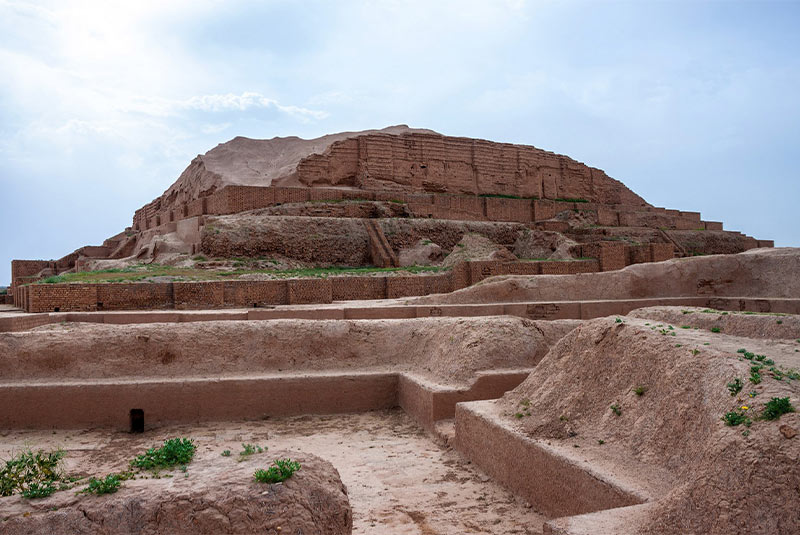
An ancient site called Chogha Zanbil, which is one of the historical places in Iran, can be found in the Khuzestan region, close to Susa (30 km or 19 mi away). It is a temple that has survived from the Elamite period, around 1250 BC, from the ancient city of Dur Untash. The temple had five floors and was roughly 52 meters high, but only two and a half of them were still standing. One of the earliest historical monuments in Iran to be included on the World Heritage List is Chogha Zanbil. Elamite inscriptions on 5000 bricks of the temple, an intriguing water supply system, and an old observatory are just a few of this landmark's fascinating features.
2. The Historical Hydraulic System of Shushtar in Khuzestan
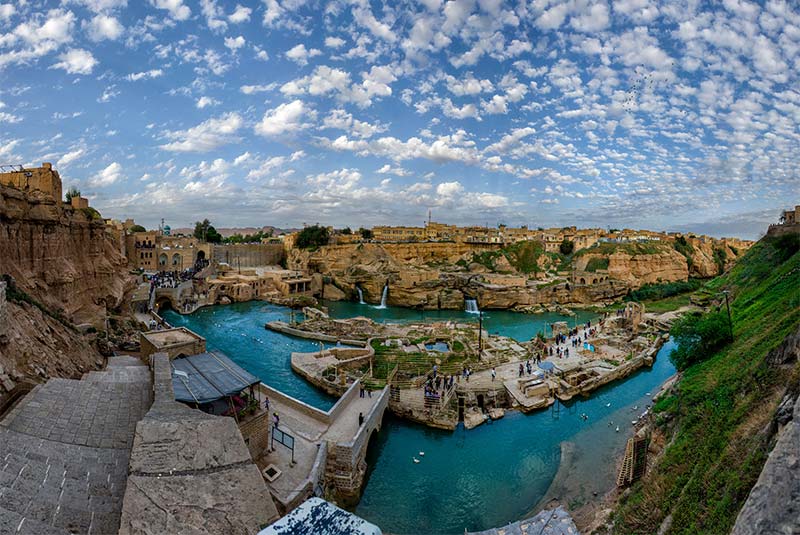
This system is a connected network of water mills, waterfalls, canals, and tunnels in the city of Shushtar, province of Khuzestan. It was constructed and improved for controlling water flow throughout the Achaemenid (500 BC) and Sasanid (300 BC) eras. This system is referred regarded be the largest industrial complex existing prior to the industrial revolution by Madam Jane Dieulafoy, a French archaeologist. If you have chosen to visit Chogha Zanbil ziggurat, be sure to include this location in your itinerary as well.
3. Naghsh-E Jahan Square in Isfahan

The city of Isfahan's main square is a significant historical location that is one of the unique places in Iran. The Keisaria gate, which leads to the Isfahan Grand Bazaar, the Shah mosque, the Sheikh Lotf Allah mosque, and the Ali Qapu palace, are four historical structures from the Safavid dynasty, which lasted from the 16th to the 17th century. The big market and this plaza are both filled with stores that sell souvenirs and handicrafts from Isfahan. One of the most beautiful places in Iran, Naghsh-e Jahan Square is also one of the biggest squares in the entire world. The spring season is the ideal time to visit Isfahan and Naghsh-e Jahan Square.
4. Si-O-Se Pol Bridge in Isfahan
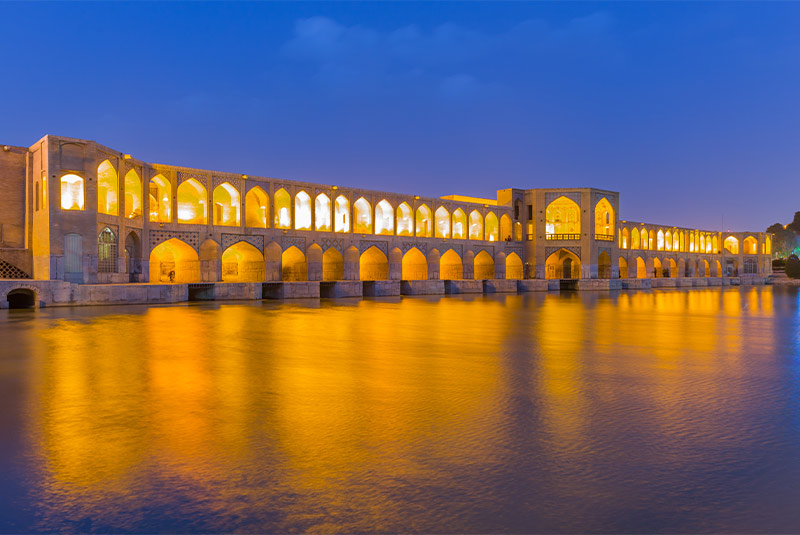
This bridge is one of the most beautiful places in Iran and is located in Isfahan city. The Zajandeh River (Zajanderud) is crossed by 11 bridges; however, this one is the biggest one. The bridge's construction was finished in the 17th century so that it could serve as both a bridge and a dam. Its interior formerly had artwork and is over 300 meters long.
5. Ali Qapu Palace in Isfahan

Another noteworthy piece of Iranian heritage is the Isfahan Ali Qapu Palace which is constructed by the Safavid Empire and is one of the most famous places in Iran.
UNESCO has listed this stunning palace as a World Heritage Site.
The Safavid monarchs utilized it as both their home and a venue for important royal gatherings.
The terrace on the fourth floor of the palace, from which you can see two of the most beautiful Iranian mosques— the Sheikh Lotofollah and the Shah Mosque— and Naqsh-e Jahan Square, is one of the palace's most spectacular features.
The fact that each floor has its own unique decorations and embellishments, such as the staircase's yellow and Persian blue tile work, elaborate floral patterns, or stunning stucco works, is surprising.
6. Sheikh Lotfollah Mosque in Isfahan
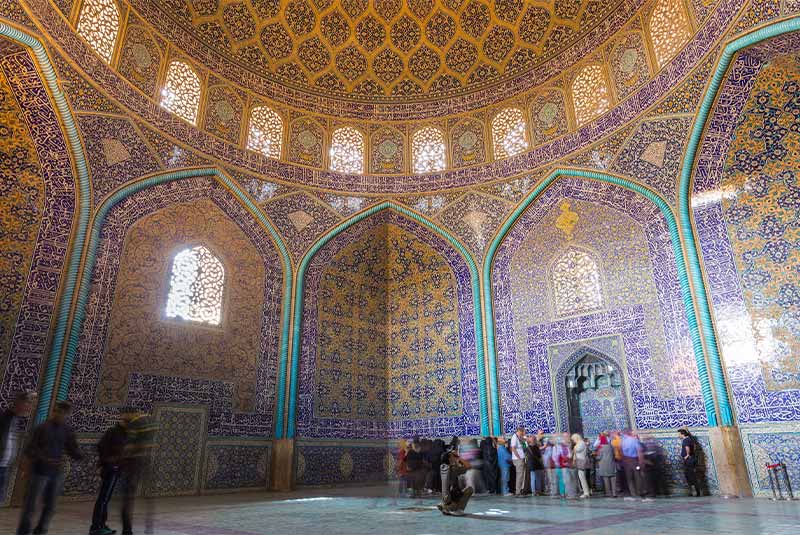
The Safavid monarchy created the exquisite and enchanted Sheikh Lotfollah Mosque in the 17th century, which is situated at one of Iran's seven wonders, the Naqsh-e Jahan Square. It is Isfahan's most elegant and magnificent monument.
It was created as a personal royal mosque for Shah Abbas. It is much smaller than other mosques and lacks a minaret since it was built as a private mosque only for the monarch and the ladies in his harem, but the tile work is significantly more intricate than that of the other mosques at Naqsh-e Jahan Square.
Shah Abbas even constructed a tunnel to link his own mosque to the Ali Qapu Palace. He and the women of his haram were able to go between the two locations covertly by using the tunnel.
7. Shah Mosque in Isfahan
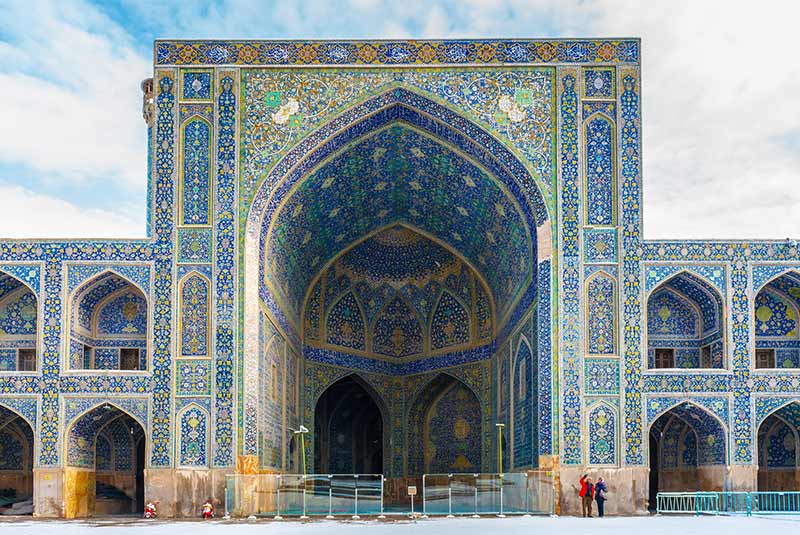
The Shah Mosque is one of Iran's seven wonders and one of the most renowned examples of Islamic-era Persian architecture. It makes sense why it is listed with Naqsh-e Jahan Square as a UNESCO World Heritage Site. Even the Iranian 20,000 rial banknote depicts this mosque.
In the seventeenth century, the Safavid Dynasty constructed it. Seven-colored wall tiles are used to create stunning mosaic patterns and calligraphy on the walls and ceilings. The Shah Mosque's magnificence and grandeur will compel you to stay there for several hours.
8. Jameh Mosque in Isfahan
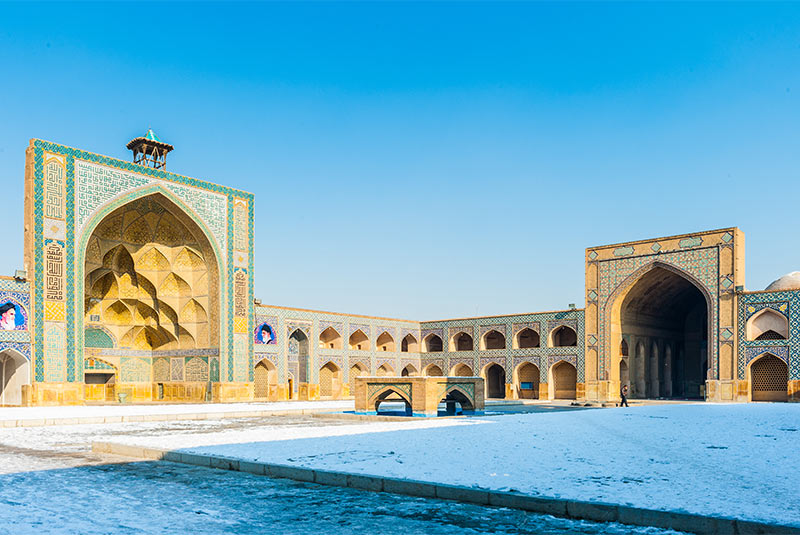
It is one of Iran's oldest mosques and is recognized by UNESCO as a World Heritage Site.
The Jameh Mosque has undergone several structural, and architectural remodels since the Umayyad Dynasty first began building it in the eighth century.
It was constructed using four-iwan design principles. The iwan is a style of the gate with a square area surrounded on three sides by walls. Four gates are arranged face to face in the four-iwan style.
The Safavids introduced some of the most beautiful features, including exquisite muqarnas (niche-like chambers), vibrant glazed tilework, and minarets.
9. Persepolis and Pasargadae – Near Shiraz

Perspolis is one of the most important historical places in Iran. Without question, Iran's most well-known historical location is Persepolis. Between 550 to 330 BC, it served as the Achaemenid Empire's ceremonial capital. It was named one of Iran's seven wonders and a UNESCO World Heritage Site because of its historical significance.
Persepolis is thought to have been constructed in 530 BC, during the reign of Darius the Great. Other Achaemenid monarchs ruled for a further 120 years while the work was ongoing. It was never finished, though, and in 330 BC, Alexander the Great, leader of the ancient Greek country of Macedon, attacked and destroyed it.
If you have the time, you may also visit Naqsh-e Rustam, commonly known as "The City of the Dead," the most exquisite necropolis of ancient Persia. You will need about an hour to explore the magnificent Persepolis, which is only a short distance away (12 km/7.5 mi). Four enormous tombs cut onto a large rock face may be seen at this breathtaking ancient monument.
10. Nasir Ol Molk Mosque in Shiraz
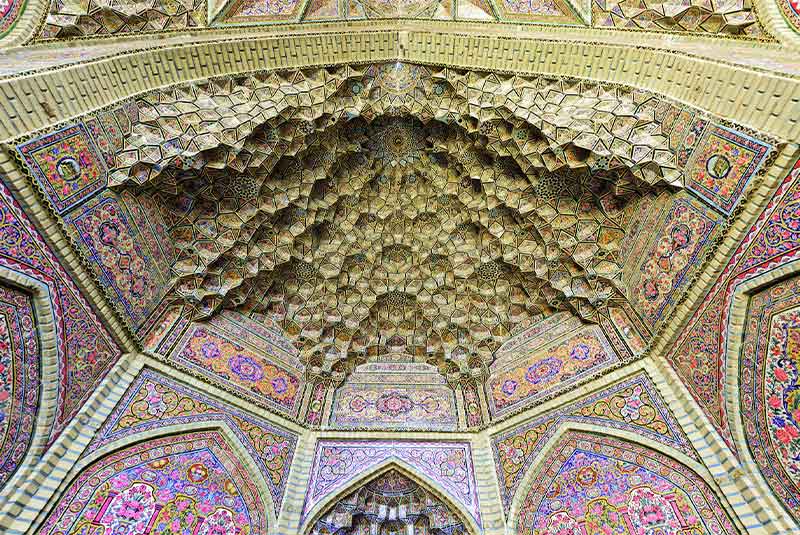
The Qajar Dynasty constructed this magnificent mosque, which is also one of Iran's seven wonders, in the second half of the 19th century, along with several other Iranian architectural marvels. It is also known as the Rainbow Mosque, Kaleidoscope Mosque, the Mosque of Colors, or the Pink Mosque of Shiraz.
The mosque is well-known for its extensive use of pink-colored tiles in both the interior decoration of the mosque and the courtyard's tilework.
The mosque's interior features five concaves, stained-glass windows of various colors, and other traditional features that together give the impression that you are within a kaleidoscope.
The entire mosque hall is bathed in a glittering rainbow of hues as the sun shines on the stained glass. It is one of the most beautiful places in Iran precisely because of this.
The sunrise is the most wonderful moment to visit this vibrant mosque. The colors in the mosque begin to dance as the sun rises, giving the impression that the building is filled with hundreds of beautiful butterflies!
As the sun reflects off the stained glass designs on the mosque's Persian carpets at this time, they also become lit. To be among the first to experience this wonder, make sure to arrive before the doors open to guests.
11. Qavam House and Narenjestan Garden in Shiraz
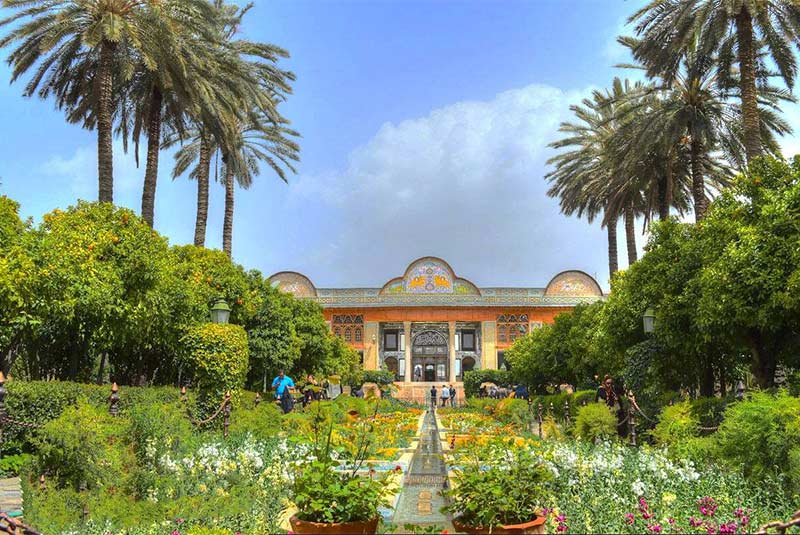
The Naranjestan Garden is a wonderful Persian garden filled with lovely walkways, waterways, fountains, and ponds that are encircled by lovely flowers and plants, including date palms and sour orange trees.
Due to the abundance of orange trees, this stunning location was given the name Naranjestan.
The lovely Narenjasten Monument, also known as the Qavam House, will strike your attention as soon as you reach the garden. Inside and outside, the monument's walls are adorned with stunning Persian murals, mirrors, tile, stone, mosaic, stucco, and wooden carvings.
Because the Qavam family created and lived in this ancient and historical monument, it is also known as the Qavam House.
12. Vakil Mosque in Shiraz
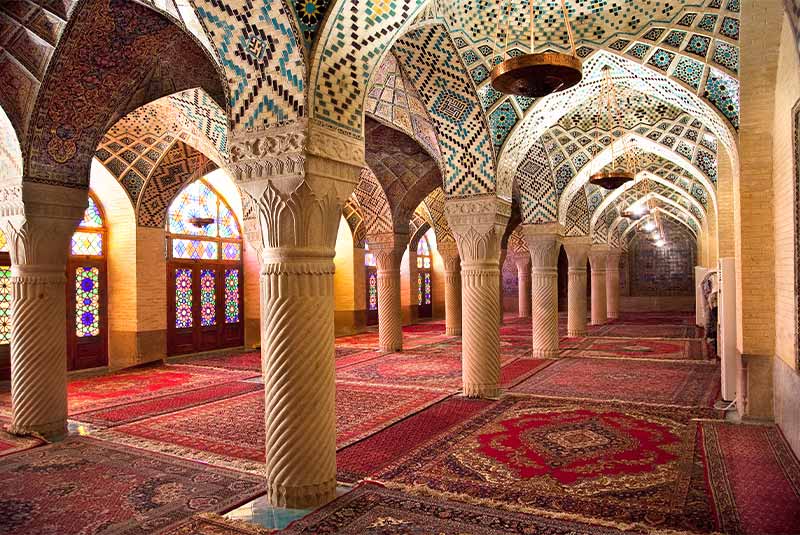
The old Vakil Bazaar, which features lovely courtyards, historical stores, and bathhouses, contains the Vakil Mosque close to the western gate, which is one of the most beautiful places in Iran.
The Vakil Mosque, one of Iran's seven wonders, was constructed by the Zand monarchy in the 18th century, and the Qajar dynasty later repaired it. The 48 spiral-carved pillars and acanthus leaves that cover the pillars of this mosque are what set it apart from other mosques.
13. Eram Garden in Shiraz

This Persian paradise garden's original design was most likely created by the Seljuk empire in the 11th century. Since then, the garden has undergone renovations and modifications by several dynasties, including the Zand, Safavid, and Qajar dynasties.
Eram is the Persian word for heaven. Yes, the location is a small piece of heaven. It is also considered one of Iran's seven wonders for this reason.
The Eram Garden has a spectacular castle in the middle of the garden, a lovely pond in the middle, and a lot of stunning trees and flowers all around the pond and palace.
The garden is home to orange, pine, cypress, and persimmon trees, in addition to some extremely tall, magnificent cedar trees. Even more attractive are the various rose species and garden flowers like jasmine, peach blooms, Japanese blossoms, or peacock blossoms.
14. Tomb Of Hafez in Shiraz
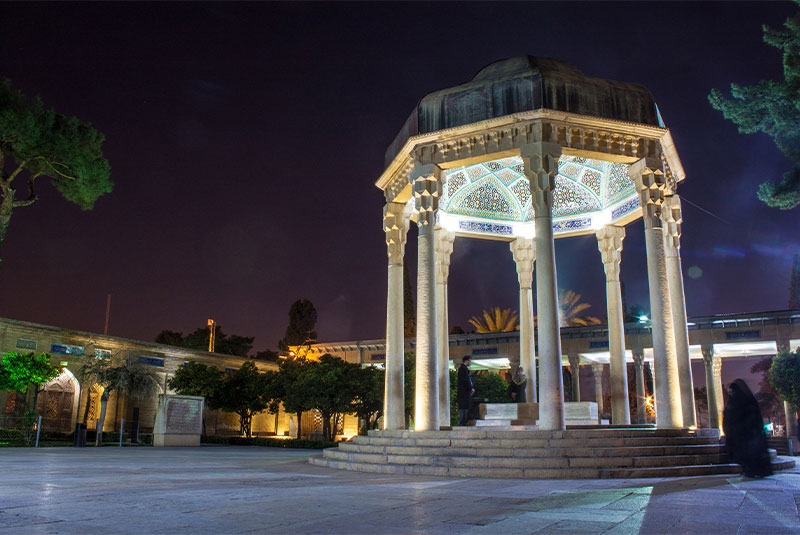
A gorgeous open pavilion with a plaque to the most renowned and recognized Persian poet and author, Hafez (1315-1390), can be seen inside the stunning Persian garden of Mossalla, which is situated in the northern district of Shiraz.
The eight pillars of the tomb dedicated to Hafez stand for the century in which he lived and wrote his masterpieces. A magnificent dome tops the eight pillars. Look up to enjoy the dome's vibrant and intricate mosaic tiles when you are below it.
15. The Historical Houses in Kashan
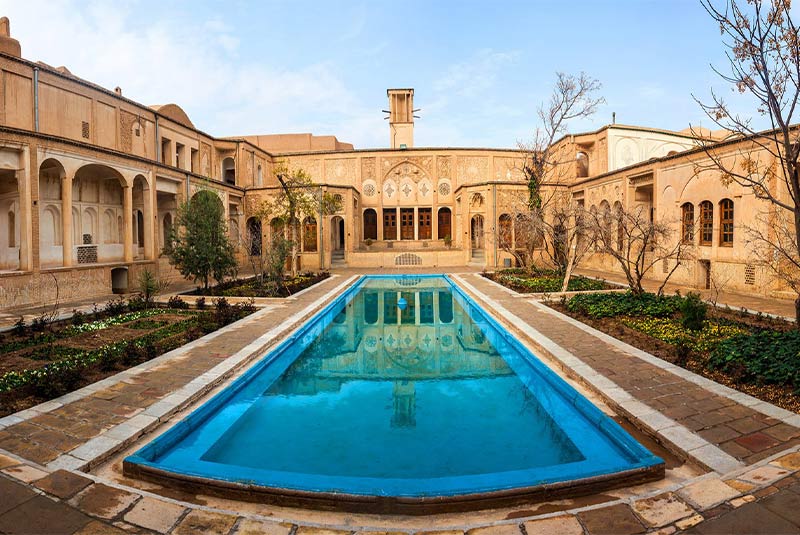
Kashan is home to elegant, substantial traditional homes from the 18th and 19th centuries, many of which have magnificent gardens and courtyards. Essentially, these are the residences of wealthy families in ancient Persia. They are now regarded as historic homes.
The Borujerdi House, Ameri House, Tabatabaei House, Abbasi House, Mahinestan Rahib House, and Manuchehri House are Kashan's most well-known historical houses.
Each traditional Persian house is a magnificent work of art. The homes are expertly ornamented and adorned both inside and out. In particular, the gorgeous frescoes, amazing mirror works, and vivid stained-glass windows are extraordinarily attractive.
16. Fin Garden in Kashan

The stunning Fin Garden, which was constructed in the 16th century, is Iran's first Persian garden. The Fin Garden is one of nine Persian gardens included on the list of UNESCO World Heritage Sites.
There are exquisitely adorned architectural marvels, opulent fountains, pools, magnificent plants, and flowers there. The Safavid, Zand, and Qajar dynasties, three well-known Persian dynasties, are represented through the confluence of their architectural styles in these structures.
17. Azadi Tower in Tehran
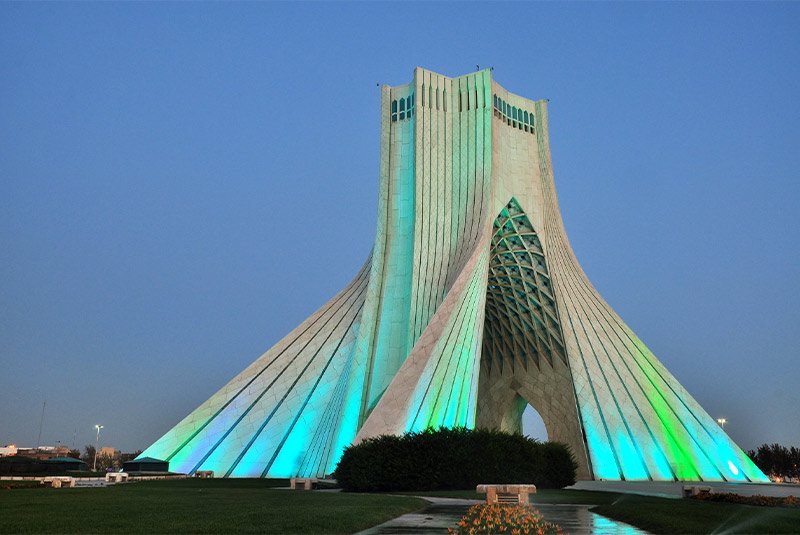
One of the most prominent monuments in Iran's capital city is the Azadi Tower. It was constructed to commemorate the 2,500th anniversary of the Persian Empire's founding.
You could climb the tower and get a fantastic view over Tehran from the top.
18. Golestan Palace in Tehran
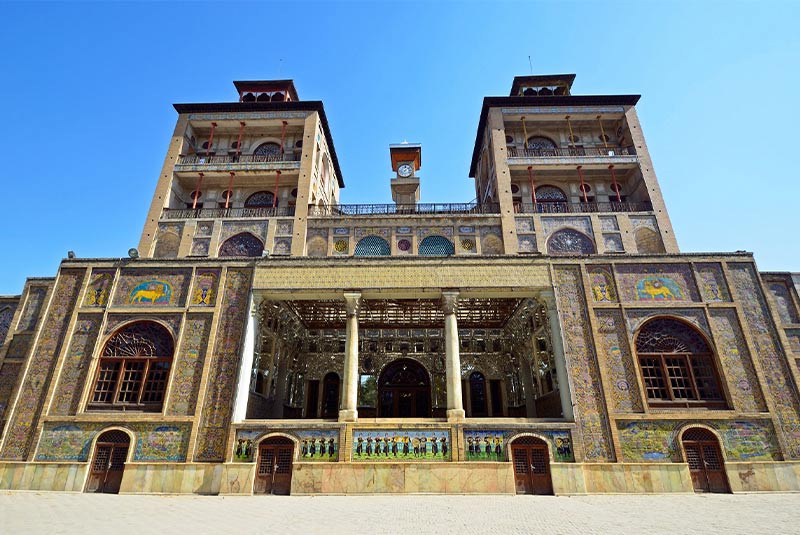
One of Tehran's oldest and most stunning historical sites is the Golestan Palace, better known as the "Palace of Flowers," which is protected as a UNESCO World Heritage Site.
It consists of 17 buildings, including palaces, halls, galleries, and museums. The majority of the monuments were built by the Qajar dynasty, which reigned from 1789 until 1925.
Visiting everything will take you two to three hours.
The Golestan Palace is close to Tehran's Grand Bazaar, where you can happily spend a few hours shopping, tasting Iranian food and beverages, and soaking up the city's atmosphere.
19. Amir Chakhmaq Complex in Yazd
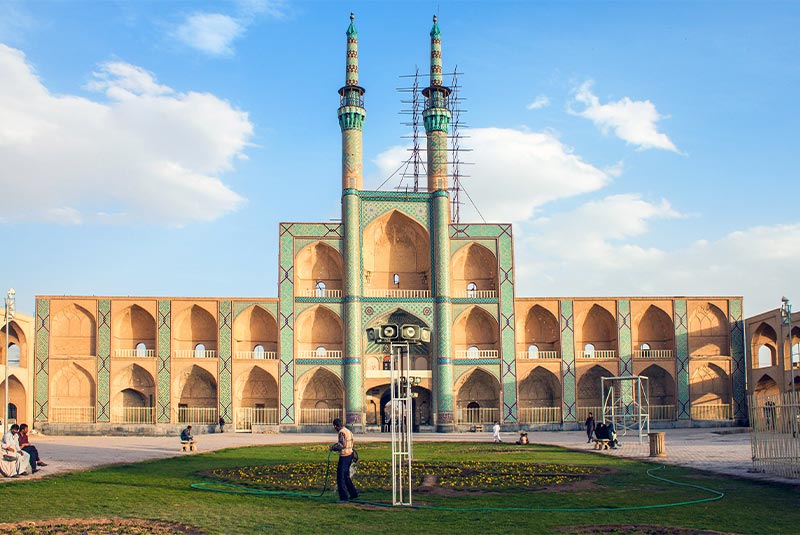
In addition to other facilities, the Amir Chakhmaq Complex has the Amir Chakhmaq Mosque, a tekyeh (a location for Shia Muslims to pray), baths, and a caravanserai with restaurants and cafés.
You might also wish to pick up some traditional local treats like Ghottab, Sohan, or Pashmak. The main attraction of the complex is the Amir Chakhmaq mosque, which dates back to the Timurid dynasty and is finished in the 15th century. The three-story front of this mosque, which has symmetrical sunken arched alcoves, is its most alluring feature.
The main attraction of the complex is the Amir Chakhmaq mosque, which dates back to the Timurid dynasty and is finished in the 15th century. The three-story front of this mosque, which has symmetrical sunken arched alcoves, is its most alluring feature.
The Most Beautiful Natural Places in Iran
If seeing mosques and historic sites isn't enough, Iran's stunning and diverse landscapes give the discerning traveler a plethora of breathtaking, unspoiled views to explore. Mountains, deserts, woods, and caverns are all present.
1. Masal Forest in Gilan (Northern Iran)

Tourists may enjoy several lovely hiking paths in the province of Gilan in the north, which has excellent natural beauty. The hilly Masal region, which is eight hour drive from Tehran, offers some particularly well-liked walking paths, but you should pack your own supplies because there aren't many stores or lodging options there. Although lynxes, wolves, and bears are rumored to live here, the blend of lush lowlands and mountain forests provides a pleasant contrast to the harsh terrain of southern Iran.
2. Latun Waterfall in Gilan

The tallest waterfall in Iran is located in the northern county of Astara, which is worth seeing when in Gilan province. Latun plunges from a height of 105 meters against a stunning landscape of wooded mountains. If you're feeling brave, you may have a relaxing dip in the peaceful waters nearby during your lunch break.
3. Churat Jungle Lake in Mazandaran (Northern Iran)
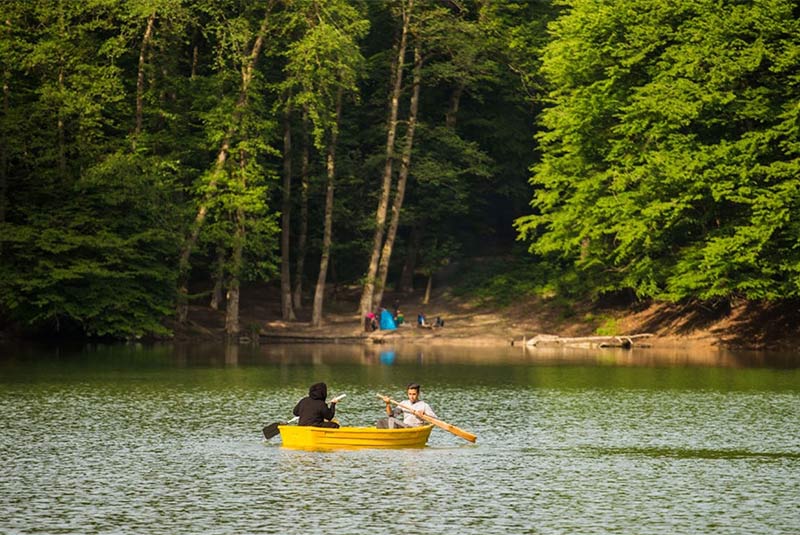
There is a natural feature known as the "Chort" or "Mianshe" Lake in various regions of the Mazandaran, which is located at the height of 1034 meters above sea level. It is regarded as the Khazar Sea's sister. This lake is close to a village with the same name and is a total of 2.5 hectares in size. The Chort is unique because of its unique design as well as its location in the middle of a forest. After numerous earthquakes in 1318 blocked the river's course, a lake eventually took the form of a mountain's steeply sloping slopes. This lake is organic, not the result of a built-in dam. The lake's greatest length and width are 380 and 140 meters, respectively, and its depth and length fluctuate throughout the year. This is one of the most popular Iran tourist places in the area and one of its attractions.
4. Badab-E Surt in Mazandaran
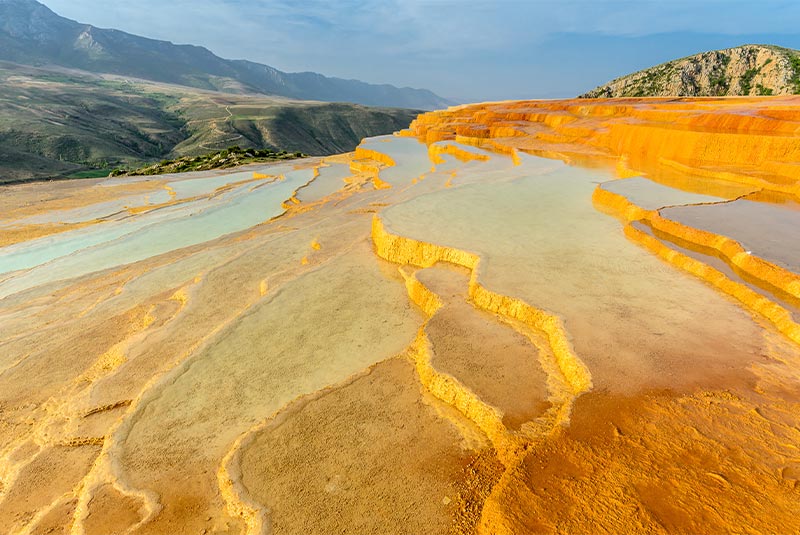
The unusual rock formations of the Badab-e Surt are a must-see natural wonder for geology buffs. The region is made up of golden, orange, and red-tiered terraces of sedimentary rock produced by deposits of minerals brought from adjacent hot springs and is situated in Mazandaran province in northern Iran, some 100 kilometers south of the city of Sari. The shimmering flats are among Iran's most picturesque locations, and the two springs of the travertine landscape are believed to have medical characteristics.
5. Mount Damavand in Tehran

The Middle East's tallest mountain, Mount Damavand, lies more than 65 kilometers north of Tehran and rises to a height of 5,610 meters. It is a challenging climb for experienced mountaineers. The mountain, which is permanently covered in snow and is clearly seen from Tehran, is a significant figure in Persian literature and culture. Reaching Damavand's top, which is in the Alborz Mountain range, will take the better part of two days and win you the utmost respect of any Iranians in your life.
6. Dasht-E Lut (The Kaluts) Desert
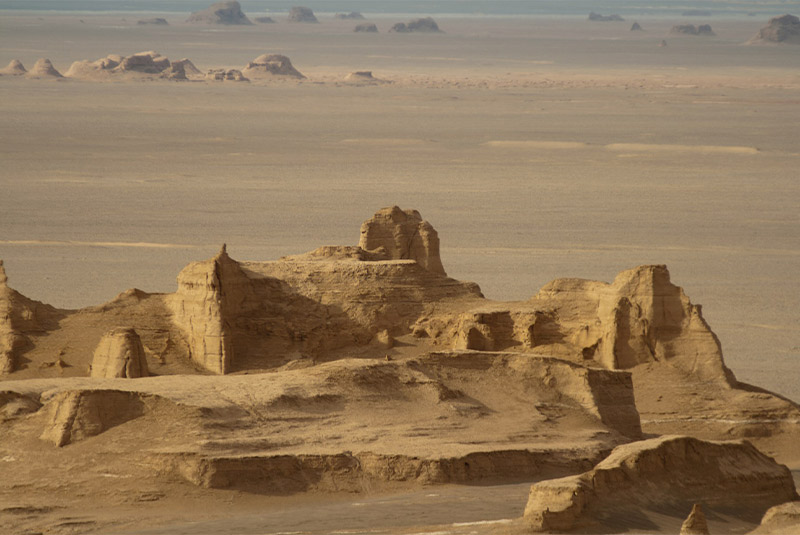
In Kerman Province's Shahdad area is where you'll find the Kalouts Desert. It is regarded as both the hottest zone and the hottest desert in the world. In the shade, the maximum temperature recorded was 70.7 Celsius (159.26 Fahrenheit).
There's a reason that this beautiful desert is included as a UNESCO World Heritage Site. Huge rock formations, astonishingly tall sand dunes, salt plains, and desert castle ruins can all be found here.
7. Maharloo Lake in Shiraz

Maharloo lake is one of the most beautiful natural places in Iran. It's a spectacularly beautiful seasonal salt lake.
Maharloo Lake is pink; you might ask why; The lake has a diversity of salts. By midsummer, the lake's algae had multiplied due to high evaporation rates and salt concentrations, turning the water pinkish-red. Red tide is the name of this phenomenon.
Travel there between July and September during the dry season if you want to see the lake pink. Maharloo Lake is less pink throughout the remainder of the year.
8. Maranjab Desert – Near Kashan

The Maranjab desert, which is two hours drive from Kashan in the province of Isfahan, is home to some of the nation's sandiest dunes. Maranjab appeals to more conventional desert imaginations, in contrast to the majority of Iran's deserts, which are salt, stony, or scrubland. You have the opportunity to combine a tour with a trip to the nearby Namak Lake and lay your head in the ruins of a caravanserai from the sixteenth century.
9. Namak Lake – Near Kashan
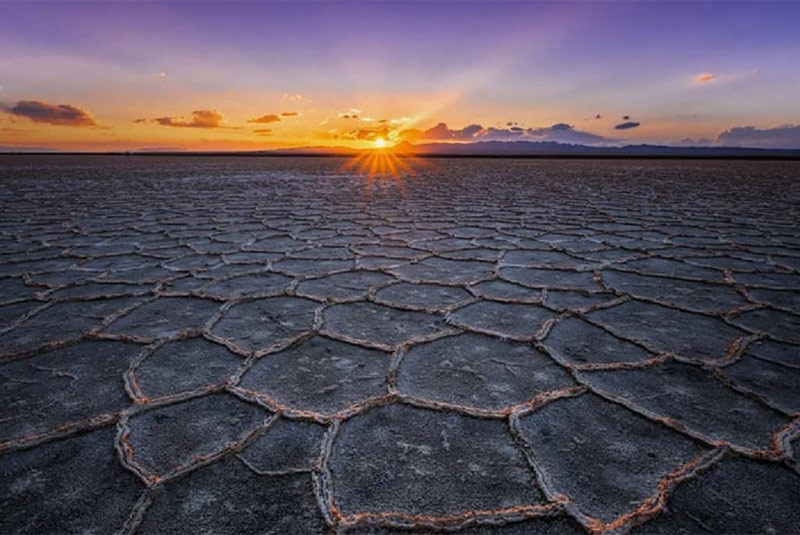
Iran has a salt lake called Namak Lake. About 60 kilometers away from Kashan. Despite being enormous, the lake is largely dry. The lake will be less dry if you visit it in the winter since some water will rise to the salt's surface.
The lake and the area around it are breathtaking. Especially memorable is the sunset over salt lake.
10. Chahkooh Canyon on Qeshm Island

One of the breathtaking natural features of the UNESCO Geopark of Qeshm Island is the Chahkooh Canyon.
Two canyons are vertically piled onto one another here. This masterpiece appears to be the work of an artist, but it was really made over thousands of years by natural forces, including sea waves, wind, and rain.
It once held a great deal of significance for the local populace. The people dug wells for themselves in order to preserve and utilize the water flowing down the canyon. Because of this, the canyon is known as Chahkooh, which translates mount well.
11. Valley of Stars on Qeshm Island
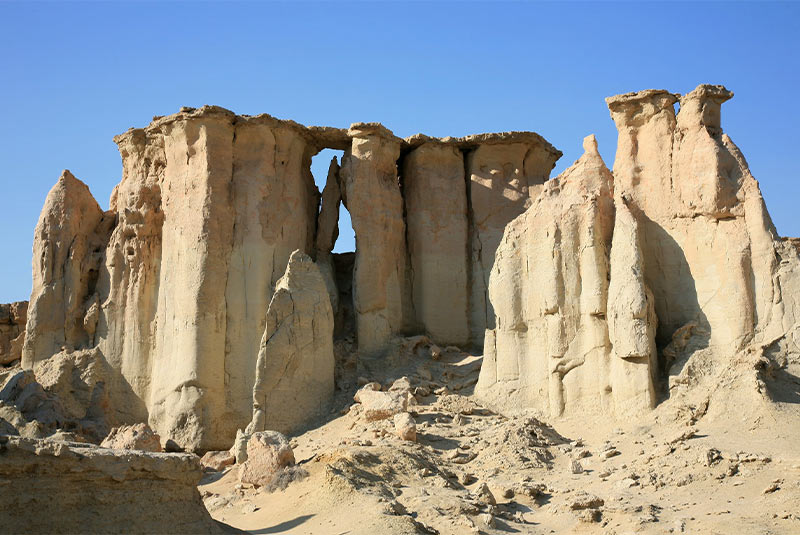
The main draw of the UNESCO Global Geopark on Qeshm Island is The Valley of Stars. The Valley of Stars, a two million-year-old natural phenomenon, is home to stunning rock formations amid spectacular canyons and gorges.
The natives said that a meteor had previously fallen from the sky and produced the strange rock formations there. They also refer to it as the Valley of Stars for this reason. In contrast to traditional lore, scientific studies indicate that the odd rock formations were created over thousands of years by wind and water erosion.
It is very amazing to go around among the valley's tall and enigmatic rock formations. The canyon's apex can also be reached through climbing. The evening is the greatest and most spectacular time to do it since the colors and hues of the valley are always changing as the sun goes down.
You may spend the night there as well. However, in such a scenario, be prepared to encounter ghouls and jinn. In the valley, they are making odd and terrifying noises. It must be quite terrifying!
12. Valley of Statues on Hormoz Island

You may find magnificent rocks at the Valley of Statues that are shaped like dragons, birds, and other fantastical creatures. Tall boulders in the valley were carved into these odd forms by nature. And for this reason, the area is known as the Valley of Statues.
You enjoy one of the most beautiful views of the Persian Gulf from the valley's cliffs.
13. Red Beach on Hormoz Island

One of the strangest beaches in the world is Red Beach on Hormuz Island. The beach and sea are both red due to the red sand in the area.
Red Beach is one the most beautiful places in Iran that you should definitely visit there.
The soil has a lot of iron oxide, which is why the sand is red. The pinkish tint of the water in the sea is also caused by the red sand.
14. Silence Valley on Hormoz Island

Another breathtakingly gorgeous natural landmark on Hormuz Island is the Silence Valley. It will undoubtedly blow your mind and be an experience you won't forget to wander through the beautiful mountains and rocks of the Silence Valley.
Bottom Line
Iran is a country rich in history, culture, and natural beauty and is full of sights to see and things to do.
It could be hard to decide which locations should be your top priority, but in this blog, we prepared a list of the most beautiful places in Iran that you really must see when visiting this fascinating ancient country.


Comment
Leave a Comment